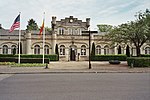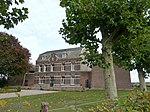Cauberg
Amstel Gold RaceClimbs in cycle racing in the NetherlandsCyclo-cross racesHills of South Limburg (Netherlands)Mountains and hills of the Netherlands ... and 1 more
Valkenburg aan de Geul

The Cauberg is a hill in Valkenburg aan de Geul, a town in the South Limburg region of the Netherlands. The hill played an important role in the early development of tourism in Valkenburg. Today, several major tourist attractions are situated on or nearby Cauberg. The hill's fame is mainly due to the many cycling races and championships that were held here. The length of the climb is around 1,200 metres (0.7 mi), with a maximum grade of 12%.
Excerpt from the Wikipedia article Cauberg (License: CC BY-SA 3.0, Authors, Images).Cauberg
Cauberg, Valkenburg aan de Geul
Geographical coordinates (GPS) Address Nearby Places Show on map
Geographical coordinates (GPS)
| Latitude | Longitude |
|---|---|
| N 50.861061111111 ° | E 5.8236805555556 ° |
Address
Buitensauna
Cauberg
6301 BS Valkenburg aan de Geul
Limburg, Netherlands
Open on Google Maps








